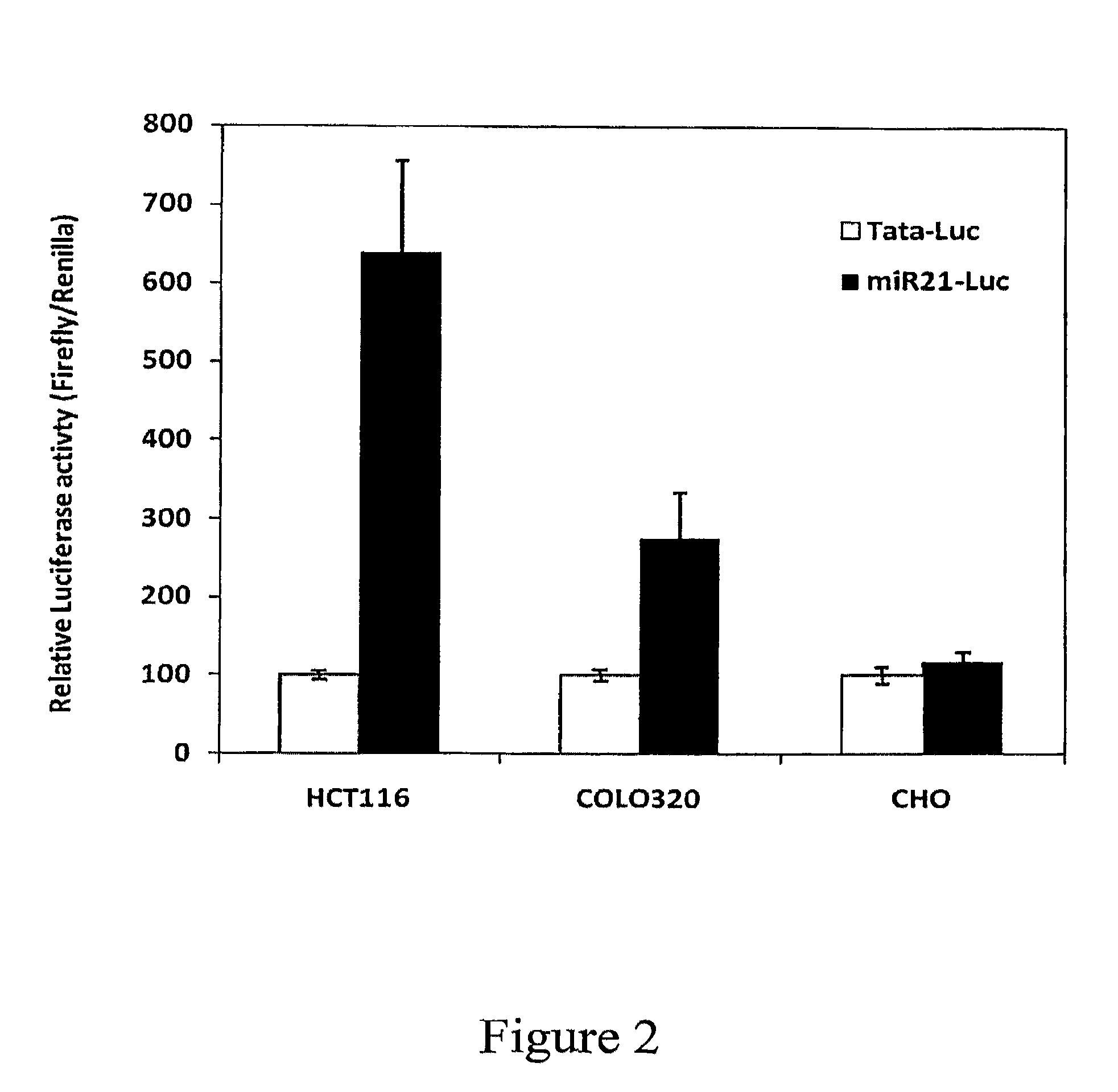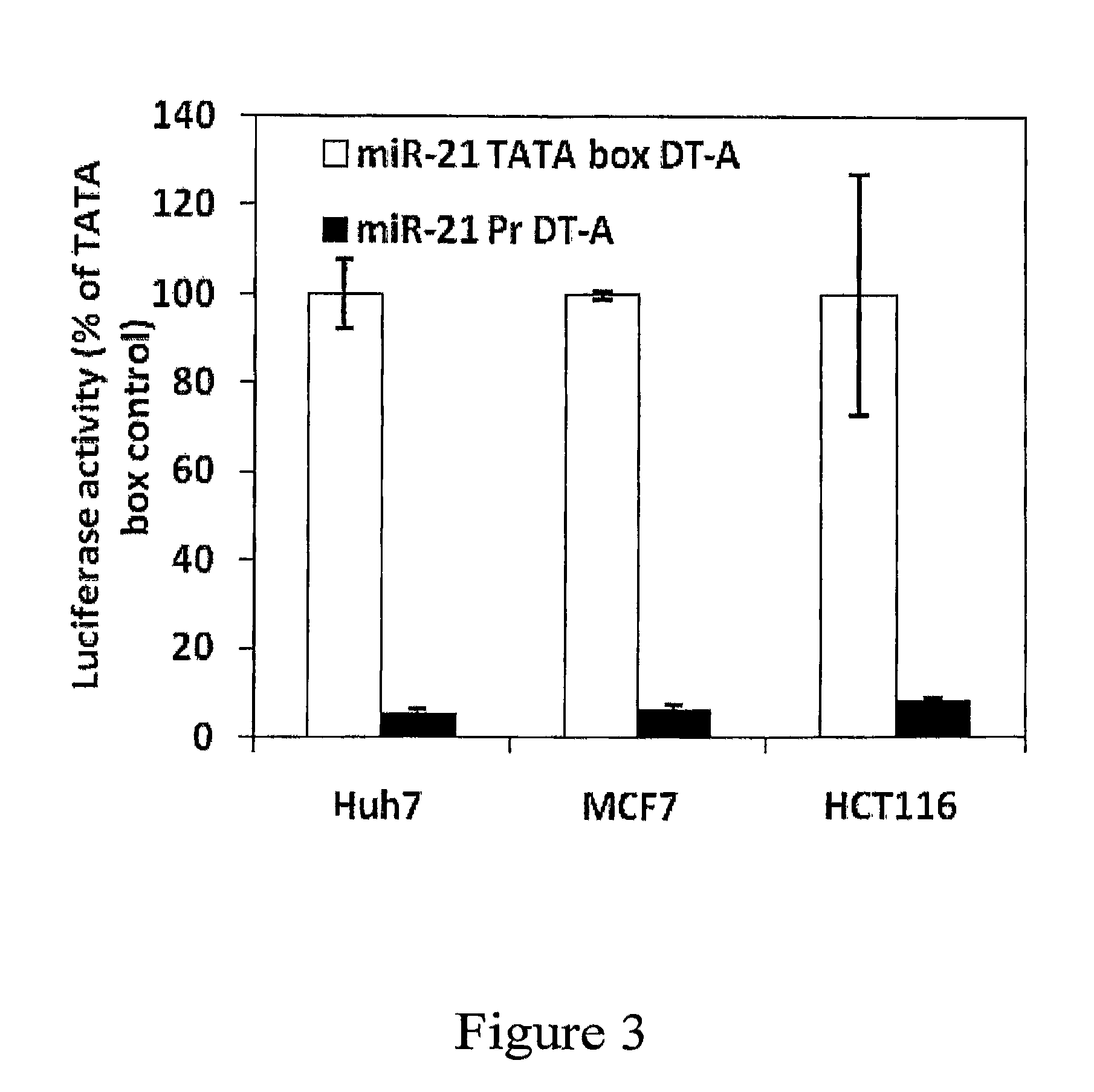MIR-21 promoter driven targeted cancer therapy
a tumor and promoter technology, applied in the field of cancer treatment, can solve the problems that the use of hitherto known gene therapy vectors is likely to fail in a substantial number of patients, and achieve the effects of inhibiting tumor metastasis, inhibiting tumor progression, and inhibiting tumor progression
- Summary
- Abstract
- Description
- Claims
- Application Information
AI Technical Summary
Benefits of technology
Problems solved by technology
Method used
Image
Examples
example 1
Differential Expression of Endogenous miR-21 in Cancer Cells and Tissues
[0233]Table 1 summarizes the differential miR-21 expression in cancerous vs. non-cancerous tissues and cells (NS=not specified).
[0234]
TABLE 1Fold over Tumor / cancer expression typeMethod(Mean)ReferenceGlioblastomaMicroarray, Northern [5]blotsreal-time PCR10-40 [6]Breast cancerMicroarray1.6 [7]In situ hybridizationNS [8]Real-time PCR5 [9]Real-time PCRNS[10]Microarray2[11]HepatocellularMicroarray~2[12]carcinomassmall RNA cloning and4.5[13]sequencingreal-time PCR>2[14]Microarray, real-time10-45[15]PCRCholangiocarcinomaNorthern blots and real- 6-12[16]time polymerase chainreactionPancreatic endocrineMidroarrayNS[17]and acinar tumorsPancreatic cancerMicroarray15.7[18]In situ hybridizationNS[19]Lung, breast, stomach,MicroarrayNS[20]prostate, colon, andpancreatic tumorsChronic lymphocyticmiRNA cloning and~3[21]leukemiareal-time-PCROsteosarcomamiRNA cloning andNS[22]real-time-PCR,Northern blotsEndometrioid ovarianMicroar...
example 2
Expression of Heterologous Genes Under miR-21 Promoter Control
[0235]A recombinant vector that expresses the firefly luciferase gene (Luc) under the control of a miR-21 promoter sequence (miR-21-Luc; SEQ ID NO: 11) was produced by standard recombinant procedures, as detailed herein. As a negative control, a vector containing the TATA box of the miR-21 promoter (TATA-Luc; SEQ ID NO: 20), rather than the miR-21 promoter, was prepared.
[0236]The human hepatocellular carcinoma cell line Huh7 was used as a genomic DNA template for amplification of an miR-21 promoter sequence of SEQ ID NO: 1, using the following primers: fw 5′-GGGGTACCGAAGGAGCTCCGAGTA CATAAAT-3′ (SEQ ID NO: 14) and rev 5′-CCCAAGCTTCTACTCTGGTATGGCACAAAG 3′ (SEQ ID NO: 15). The PCR product was cloned into the pGL3-Basic (Promega, Madison, Wis.) vector, which carries the firefly luciferase gene.
[0237]A DNA sequence corresponding to the TATA box of the miR-21 promoter (SEQ ID NO: 6) was constructed by annealing the following ol...
example 3
miR-21 Promoter Driven “Killer Gene” Expression
[0240]To determine the ability of regulatory promoter sequences of miR-21 to specifically drive the expression of a “killer gene”, the luciferase coding regions of the reporter and control vectors described in Example 2 were replaced with a nucleic acid sequence encoding the cytotoxic fragment A of diphtheria toxin (DT-A). DT-A inhibits protein synthesis, triggers apoptosis and detachment of cells, and has been previously used as a “killer gene” for targeting cancer cells.
[0241]The DNA sequence encoding DT-A, and the corresponding amino acid sequence are provided herein as SEQ ID NO: 18 and SEQ ID NO: 19, respectively. The constructed plasmids containing the miR-21 promoter sequence of SEQ ID NO:1 or its TATA box of SEQ ID NO: 6 were respectively designated miR-21 Pr-DT-A (SEQ ID NO: 9) and miR-21 TATA box DT-A (SEQ ID NO: 13).
[0242]Apoptosis levels and protein synthesis rates were determined to confirm the miR-21 promoter-driven expres...
PUM
| Property | Measurement | Unit |
|---|---|---|
| temperature | aaaaa | aaaaa |
| pH | aaaaa | aaaaa |
| pH | aaaaa | aaaaa |
Abstract
Description
Claims
Application Information
 Login to View More
Login to View More - R&D
- Intellectual Property
- Life Sciences
- Materials
- Tech Scout
- Unparalleled Data Quality
- Higher Quality Content
- 60% Fewer Hallucinations
Browse by: Latest US Patents, China's latest patents, Technical Efficacy Thesaurus, Application Domain, Technology Topic, Popular Technical Reports.
© 2025 PatSnap. All rights reserved.Legal|Privacy policy|Modern Slavery Act Transparency Statement|Sitemap|About US| Contact US: help@patsnap.com



